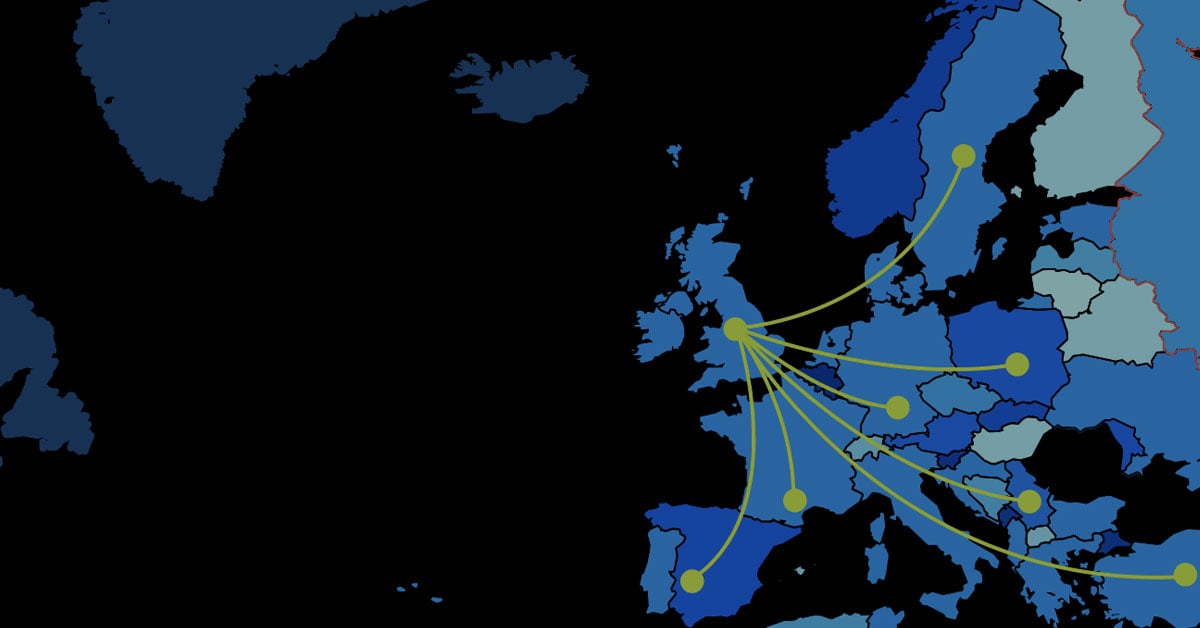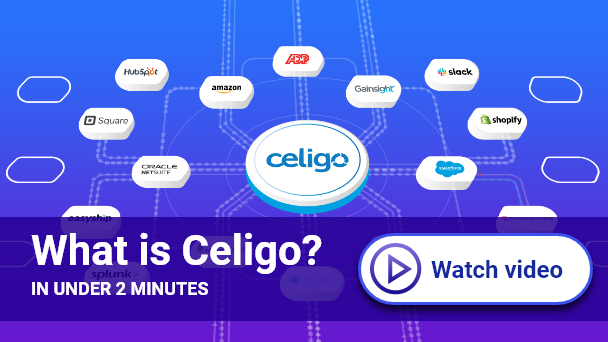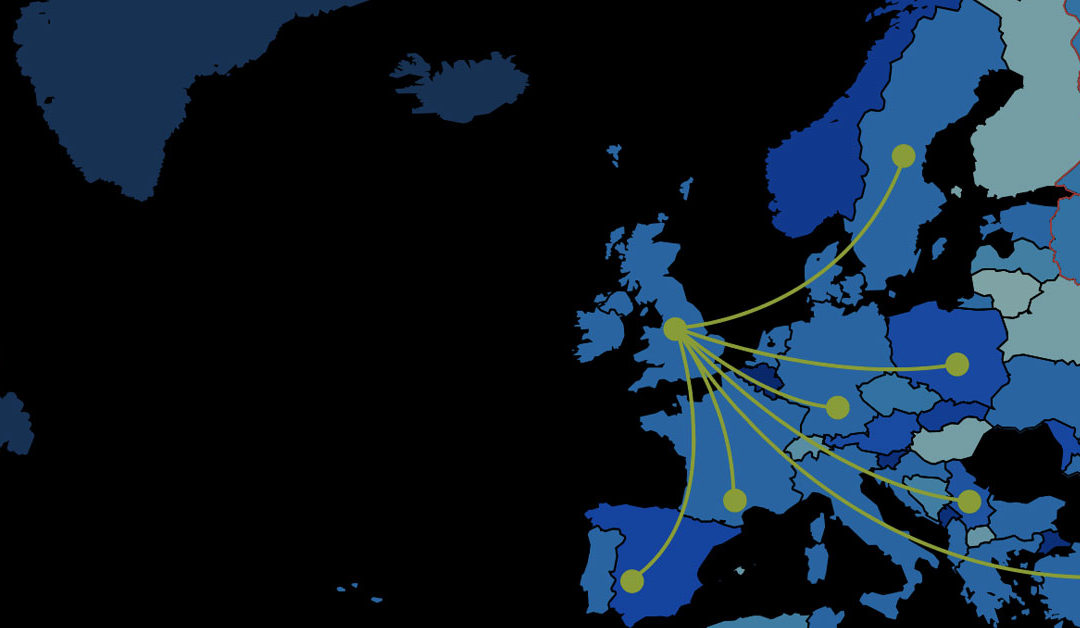On Demand Webinar
Selling in Fragmented European Markets: Automating Feed Management

Businesses taking a multi-channel sales approach using different ecommerce marketplaces — in addition to their retail locations and webstores — need to ensure product information is consistent across these different channels. If they are leveraging 3PLs for fulfillment, they also need to ensure product information is up-to-date at different warehouse locations, especially when dealing with marketplaces in multiple countries.
When product information is not centrally managed and automatically updated across different channels, the resulting manual process requires a lot of hours, introducing errors and slowing down sales and fulfillment.
Join Henk Kooiker, Director of ZangaBee, and Rico Andrade, VP of Marketing from Celigo share best practices on how to efficiently manage items across sales channels, marketplaces, and warehouses to reduce operational costs and speed up sales.
Topics that we discuss include:
- The challenges of maintaining accurate inventory in multiple warehouses
- Selling in fragmented European markets
- Best practices for eliminating hours of manual data processing
- Achieving visibility of products on various ecommerce platforms for commercial purposes
- Optimizing feed and data quality to reduce operational expenses and costs
Watch now!
Full Webinar Transcript
Ready? Welcome to the Celigo and ZangaBee webinar, titled, Selling in Multiple Fragment Markets. Specifically about automating feed management. This is a very relevant topic for companies who are trying to sell particularly in Europe. And we’re very excited that we’re going to bring Henk Kooiker, the founder and director of ZangaBee, a solution provider based in the Netherlands. My name is Rico Andrade, I’m the VP of Marketing at Celigo. And before we get started a couple housekeeping items. First, the session is being recorded. So we will be sending a recording of the session afterwards. Also, we will be taking questions. So feel free to put your questions in the questions or chat area of the GotoWebinar interface, and we hope to make this an interactive session. So we definitely do encourage you. There will be time for us to answer those questions at the end of this webinar. So, for the agenda, we’re going to do a very quick introduction of Celigo and then jump into ZangaBee and their experience with this particular issue. From there, we’ll talk about the unique challenges of selling in the fragmented market that is Europe, as well as the opportunity that it entails. And then I think we’ll go into more detail on what is feed management. And then dive a wee bit deeper into marketplaces, as it applies to feed management. We’ll discuss some of the transaction types involved in this challenge, and then what the application landscape, how it has evolved. And so the challenges that companies often see when they are trying to expand in Europe, and to 50 different marketplaces. From there, we’ll talk about the solutions as to how to architect these systems to automate the feed across the different applications. And then Henk will go into more specifics on a case study of the recent customer for his brand field, to show how ZangaBee Architect are their automated feed management solution. We’ll save some Q&A for the end, and we will be taking questions as we go along as well. For a very quick introduction to Celigo, if you’re not familiar with Celigo. Celigo is an integration platform, an iPass. And what an integration platform allows you to do is to quickly connect and automate processes across thousands of different applications. So you could either connect different applications to talk to each other via pre-built connectors directly in the application, or if the application is not in Celigo, there are universal connectors that accelerate how you can connect to things like Resco ATIs, TP, web services, and beyond. In terms of the Celigo customer base and what we do, we have several thousand customers across the world. Many of them are based in Europe. We have been doing integrations for over 10 years, and we have a particular expertise in terms of ERP integrations and the ecommerce integrations. Many of these integrations already have been– we’ve created best-practice prebuilt integrations, out of the box. Because we’ve seen those use cases so many times. As I mentioned, we do have global presence. We’re headquartered in the US. Our European headquarters is in Amsterdam. We have a presence in London and beyond. With offices in Asia as well. And more recently, last year, we opened our data center for Europe in Hanover, Germany. With the specific goals of GDPR compliance and other European compliances of having servers on European countries. So that’s it for a quick introduction to Celigo. So with that, I would like to pass off to Henk to introduce ZangaBeeand get us started with this very interesting topic. Thank you for being here, Henk. Yeah. Thenks, Rico. So welcome, everybody. My name is Henk. I’m based out of the Hague in the Netherlands. Worked in corporate IT for many years and then thought, “Well, let’s let’s try to build a company myself.” So we became a solution provider, a suite success partner. But as it happens and I’ve seen that in my past as well, integration is always a big part of a customer becoming successful. So we looked into various integration platforms, but soon found that Celigo was a very good one, and we decided to partner up with them. And we have not regretted that, because we really like the platform. And I’ll touch on that later. Amazingly, it allows me and my company to have all of our experiences, because we are a pretty mature bunch of people, and we can feed it into those NetSuite and Celigo solutions. What we also found in our history in our past is if you have a close relationship with your customers, you’re really transparent about what you do, so we prefer to work in the customer’s environment so if they have Jira, we want to work in their Jira, because then they see what we do and then you get the best relationship and you get the best trust. Also, if you’re close to that customer, then you see trends, and basically this is about recognizing a trend and talking to that trend. So that’s also why we’re having this webinar. All right. So, many of our customers, they have this challenge of selling into that fragmented marketplace. So, let me close this, because this is a bit annoying. That fragmented marketplace can be you’re based out of the Netherlands but you want to sell into different countries, but you also recognize that those different countries, you can have your own presence, like your .fr for France and your .es for Spain, but you also want to have your products onto that local marketplace, of which you know that in Spain, that marketplace has a really dominant position. So you have all these specific marketplaces that you want to tap into. But you also recognize that all these marketplaces, all these platforms have their own structure and their own demands when it comes to receiving data and sending data. And you have an interest in that inventory, your stock levels are represented on those marketplaces and your prices in the way that you want it. But you also have to comply with their restrictions. So all in all, it’s a challenge, but it’s also a massive opportunity because if you get it right, then you as a company, you can grow, and you can grow fast. You can probably grow faster than your internal organization can handle. So let’s move into the topic then of feed management. Let me go there. Hang on. Yeah. There we are. What is feed management? Because that’s going to be the engine for this type of business growth. Feed management is about achieving that visibility of your products on different platforms. It’s about importing that data, optimizing it, keeping it up to date, monitoring it, and reaching it where needed, and one thing, not only does the data flow as it should flow to those sales channels. Not only that. It’s also about, do I get the results out of it that I want to achieve? So is my strategy still– am I achieving what I’m after? And at the same time, you have to comply, and you have to work within the boundaries of those sales channels. Now typically, a source of a feed management solution has been the e-commerce system. So you run on Magento or Shopify. You feed that into other sales channels. But what we see is that we’re moving towards the sort of feel that an ERP system is a better source or better prime source for feed management, a starting point. So we’ll touch on that later as well in this presentation. Okay. A bit deeper into feed management: What are the areas that you can focus on? Well, it already starts with marketing, affiliate marketing, display remarketing, basically, visibility but not yet close to that basket that you’re after. So visibility of your brand, visibility of your product, and then the next step is typically cool shopping, fashion checks, those kinds of platforms where your products are visible next to others. Same for comparison sites, like Tweakers, or in the Netherlands, there is Kieskeurig. There’s typical sites where you want to be visible even if it’s next to other items, but visibility itself is important. And then we’ll zoom into that later. The next step is the marketplaces where you are close to that shopping basket. So in the Netherlands, Bol.com is very dominant. And, of course, we have Amazon, and I will touch on a couple more. Of course, the areas of focus, then we will go into the next step. We talk about inventory levels, how to be smart about that, and of course, then integral fulfillment of what people buy at those marketplaces. Okay. Moving on. I did some research. And you can quickly conclude that in Europe, there are more than 50 of these marketplaces. They probably need maybe even more than 100. But if you do a quick search, then you will already find 1 in 50. A lot of them cover more countries, but you do see that they have a certain dominance in certain countries. So in your strategy as a company that wants to sell products in multiple countries, you might say, “Well, I want this marketplace for this country, but maybe not for that country because there’s a better marketplace for that country.” So. you can really start listing which marketplace you want to go for in which country. Now, what are the benefits? I think they’re pretty obvious: more traffic, international reach, becoming more profitable, and then, of course, you’ve got your tech channels. You can analyze your performance. That really depends a bit on the marketplace and what it provides as data. But that’s a good benefit. And basically, you can reach new groups that you would not reach through your own website. Okay, what kind of information is typically requested by those marketplaces? And again, this might be pretty obvious, but let’s walk through it. Item data, the description, the pictures, the tags, the price, SEO-related or other metadata. That is certainly required. And then the next one, well, you can have a marketplace where you have your products but you don’t have an exact number thereof how many are still available. But still, inventory levels are very valuable in this data exchange. And then there’s the question, do you want to share the same stock level to all channels, or do you have certain preference because certain channels, certain marketplaces, will give you more profitability? Those are considerations. Those are pieces of information that should be fed to those marketplaces. And then, of course, what it’s all about, the transactions. It’s the orders and then the fulfillment of them. And then, is it about your own distribution center from which you want to pick, pack, and ship? Or do you have a dropship approach? There’s all kinds of flavor that you then can go forward depending on what business decisions you have made with regards to your own fulfillment. But as long as they come in via those marketplaces, then that’s a good value to your business. Of course, once transactions have started, you need to be able to send across a status track and trace data. And what’s sometimes forgotten is that the focus is on orders, but there’s also returns. And if you don’t set up your returns process smoothly, then that will hit you in the face when it comes to client satisfaction. And client satisfaction can easily be influenced by a couple of tweets of unhappy customers, so get your returns right. I think that’s the– I think that’s what we learned from the past years. Okay. Let’s now go through the evolution of a typical application landscape, and then we end up with the feed management solution. So here’s a customer ERP and a storefront, so a website of their own. And let’s say that in the UK a Shopify Ecommerce site that’s connected to the ERP NetSuite. And let’s say they want to connect also to Shopify in Germany, to an Amazon site that’s focused on the UK, to a site that’s focused in the Netherlands, and they’re all direct connections. And that’s still doable, but what if there are a couple more? And what if there are a lot of them that you want to connect to? Then it’s getting into this situation where it gets challenging, both from lack of standardization because how do you go about these connections? Are they one-offs? Are they very specific to each marketplace? And all in all, it will require a lot of IT resources to get it all done, so. And it’s not only about setting up that initial data flow of a sales order, for instance, but it’s also about the monitoring. Are the orders flowing in the right way? Shouldn’t we then build a dashboard that monitors this and that that gives a notification if something goes wrong? So that’s all part of that challenge, and your IT department will grow a lot if you want to achieve all of this through direct connections. So you’re in this challenge. You’ve got all these marketplaces that you want to connect to. And then what are your options? And we listed, I think, the two key ones here. You can go for an integration platform, and Celigo is an integration platform, an iPaaS, and that allows you to connect to those marketplaces directly, and it allows you also to connect to a whole lot of other systems. Because, as Rico explained, through Celigo you can connect to a lot of different systems. And that already helps you a lot. It helps you with a standardized way of connecting. And what I find very important is you have that out-of-the-box functionality for error handling. What if something goes wrong? The data from the source is not as the destination system would expect it to be; how do we go about that? Do we generate an email message? Do we generate something else? Do we fill in a default value for a certain mismatch? That can all be done in an integration platform. Now, another way of achieving those connections to all those marketplaces is through a feed management tool. So a feed management tool– and I’ll touch on a couple. You’ve got, for instance, Channable and ChannelEngine. Feed management tools already have established relationships and connections with those marketplaces, so it’s sort of an outsourcing of your integration efforts, and that’s also a way to go. And now the big question is what do you use when, or when should you use one versus the other? So that’s what the next slide is about. We feel that if you have a marketplace that has very specific demands, or you have very specific demands for them, then a feed management tool might be too limiting in what they can offer, and then a direct connection is very often the best way to go. So if you have a very dominant marketplace, very important one, and you have very specific requirements, then using Celigo as an integration platform would work well for you if you have smaller markets that you want to penetrate, other marketplaces that you can sort of approach in a more generic way because you’re satisfied with that, you’re okay with that.], benefit management tool could be very useful and it can help you to speed up your ambitions and your growth plans. All right. What if we now put it all into an architecture, into the picture that sort of displays how you could set up your application landscape. Now this is again Oracle NetSuite as an ERP system. It’s connected to Celigo as your integration platform. And then, there are connections from that platform to your own storefronts, in this case, it’s Shopify in multiple countries. And at the top, some very specific connections to important marketplaces because those are the ones that generate the most business for you and/or those are marketplaces that have such specific requirements, or you have specific requirements for them and for that connection, that you want this to be tailor-made for you. And then still even tailor-made can be that Celigo has a template available, but then that’s a starting point for what you want to achieve. It’s not like it’s set in stone that that template only does what it has been predefined for. No, it’s a starting point. And then what you could do for the other marketplaces, so the ones that are depicted on the right side, is that you connect to those via a feed management tool. and then ChannelEngine is a good one to go for, at least so we’ve seen that in the market as one that’s versatile. And it’s also important you need to know– yeah, you need to be able to work with these guys in a smooth way to achieve what you need to achieve for your customer. So as a consultancy firm, of course, we want to be successful for our customers. And that very often means that you have a certain preference to work with other teams, with other organizations that also have that same mindset, and that can help you and your customer to be successful. So this is typically a sample architecture that we would advise. Okay. So Brandfield, what is Brandfield? It’s a customer of ours that we started with last year. They had a landscape that was old or at least relatively old, and they wanted to do some drastic changes. They are an online retailer. They’re selling to 10 plus European countries that got a lot of different style items. They’re very much about watches and jewelry style items. And they wanted to change that landscape because they wanted to be ready for their ambitions. And they’re basically very straightforward. They’re about growth. They’re about entering new marketplaces. They wanted to use their own distribution center for pay, pack, and ship, but they also wanted to be able to do dropship. And they even wanted to be a marketplace themselves on their own website to show items of other providers, of other suppliers. So that they wanted a landscape that would allow for that. And we sat down with them together with a NetSuite implementation company, and we came to the following landscape last year and that was a very successful project. At least, I felt it was a very smooth project, of course, every project has its pains. But this, because also Brandfield themselves, are a focused bunch of people. We got to this landscape in something like six, seven months. And what was already there in that landscape. At the top, there were the Lightspeed websites, which they use for specific private brands. So Sem Lewis, Isabel Bernard, they are brands that they push into the marketplace. At the bottom, they already had their Magento sites, which are calling brandfield.nl, brandfield.fr. So their sites, their presence in multiple countries where they push their own products. What’s already there was also Channable, connected to Magento. That’s a feed management system that’s then connected to bol.com and Amazon. And what was new, is Oracle NetSuite, as in ERP, Peoplevox as their WMS, and then Celigo as the integration engine. And then we connect it to something that was also already there and that’s Tradebyte which is a key component to get access to a key local Dutch marketplace which is called Wehkamp. So that was already there but Celigo, NetSuite, and Peoplevox had to be set up and we helped them with that. But once they got to this and they were ready in time for Black Friday, and basically, the whole peak season. After that, they started thinking, “Okay, what’s next? How can we now improve on this architecture? And the next slide shows that. And it’s still a work in progress but this is a bit the way we’re progressing. So they introduced ChannelEngine. And we’re in the process of connecting the ones on the right side to ChannelEngine. So ChannelEngine has a broad set of marketplaces that they are connected to. So this is what they envision ChannelEngine to be a key component. Amazon, I think that’s to be decided how to exactly link to that. And what’s also missing in this slide but I thought of it later on, but it is key, there’s also consideration to introduce a PIM solution. So product information management, which also ties into Celigo. And a specific functionality for stock balancing. Because you can build a lot of stuff in NetSuite. Because NetSuite is a perfect platform for customization and to put scripts in there that do a lot of thinking for you also in the area of stock balancing. But architecturally, it’s smarter. Call it function placement wise, it’s smarter to have it in a separate piece of function that you connect to Celigo. So that’s also part of that architectural view. So that’s what makes Brandfield a very interesting company to work for. And to show you the last picture of the Brandfield case. It’s not only about visibility in websites, marketplaces etc. where Celigo is used for. It’s also about related processes. So if I now go to the next slide, you see that I rolled up the Lightspeed clouds into one, and I rolled up the Magento clouds into one, and I added a couple more. At the top, they got a bot-type functionality that feeds into Celigo and then onwards to ERP to NetSuite. They got Buckaroo. So Buckaroo, it is on the payment side, the financial side, while it’s connected to the websites. When it comes to refunds, a direct feed from NetSuite via Celigo to Buckaroo is better. So we created that for them. We got MessageBird connected. MessageBird is about support, and then WhatsApp-based support, MessageBird focuses on that. And I added HTG. HTG is a business partner that supplies them with products for them to sell in their Magento web store. And then through drop-ship, the order of fulfillment is passed on to HTG. So that’s also part of their landscape, and there’s probably a couple more that I haven’t added. But, basically, this brings across that– and that’s also why I like to work with Celigo, because a lot is possible, and you get a customer into a creativity mode and think, “Hey, if we can combine this–” or, “If we can link this to that, can we also link that to that?” And you get them into a mode where everybody comes up with new ideas that helps them to become more efficient. And when you’re more efficient, then you get more time to think about the next step, so what can you do as the next step to achieve your business goals, your road map that you’re after. Okay. I think Brandfield is happy with Celigo and with NetSuite and the whole solution, and I think this helps them to achieve those kinds of goals that I just mentioned. And with that, I’m handing it over to Rico. Thank you so much, Henk. That was very insightful, and I really appreciate you walking us through the architecture and detail there. Hopefully, that inspired some ideas in the audience here. We do have some questions. So the first question is, “Do you recommend hiring help to be able to achieve this? Is this something that I could build myself, in-house?” Yeah. That’s a very valid question, and that’s also, I think, well, one of the reasons why Celigo is a good platform. You could do it yourself. And that means if you have a good IT department that has the right focus on it, then you can do this yourself. But what we see a lot with– and that also gives a feeling to many of the customers– that gives a feeling that they’re not dependent on a consultancy firm. And I don’t want them to be dependent on us. If they want, they can be self-steering for sure, but what very often happens is that the first integrations we build for them, and then we move into a mode where they start looking over our shoulders to their IT guys. And then they get the hang of it, and then we get more into a coaching mode. So, at first, yes, ask us for help. But it is possible to start learning it yourself, and that’s because of the transparency of the platform and also because of the technical capabilities. I guess here’s a follow-up question then. What does Brandfield’s internal technical team look like? Well, that’s a good one. So for typical companies like Brandfield, their internal technical team is pretty limited. Very often a IT team of a company like Brandfield will focus on getting the Wi-Fi working, getting the laptops working and desktops, and then one guy or two guys that really know the integrations in the landscape. And that’s what we saw then in the implementation project. These people then become key in changing and then introducing changes in the landscape. So when they switched to NetSuite, when they switched to Celigo, these two guys that knew all the integrations, all the flows, they were very much in demand. And now what they’re doing is, they’re gradually scaling it up. So they’ve added a person that is becoming a NetSuite expert, and then we’ll also be looking into Celigo and their own guys from the business teams. So team leaders, they get into the dashboard of Celigo where they see how the flows run. So Celigo is good in that dashboard area where you can just say, “Hey, this discord didn’t come through because of this mapping error.” So next to IT staffing up, they also have their team leads of their business teams accessing Celigo and then specifically the dashboard. What are the differences between the feed management tools such as ChannelEngine and Channable? Yeah. I think ChannelEngine seems to be better equipped to link with ERP systems. And somehow the way the interaction– very often when you are asked– and that’s not specific about feed management tools but in general. If we’re asked, “Okay, can you look into this and this system? Can you integrate with it?” then I have my technical team look into that. And then either they come back with, “Hooray! This is really, really good. They’ve got a good APR. They’ve got good documentation,” or they come back to me with, “This can be a tedious one because of lack of documentation, lack of technical integration options.” So I think technically we ended up with preferring ChannelEngine, and I think also when it comes to reach, I think they’re a bit better. How did you decide which marketplaces to prioritize with Brandfield? Yeah, that’s a good one. So it’s really a business decision on their side, but yeah, typically you would look–that’s not me trying to get into their heads, but typically you would look into, “Okay. My products, which marketplaces do they fit?” and is there any reports available on how much business a marketplace gets or does in the area that you have your product. So I think that would be on the top of the criteria. How much business does, for instance, bol.com do in the area that you have your products? If that’s only a minor part of their business, then you might not want to go for bol.com but for another one. Are there upcoming marketplaces that they may be integrating in the future? Not that I know. That’s a bit difficult. We would have to check that with Brandfield, but they’ve got Zalondo, which is already on the list that they want to go for, and the other one – let me flip back -Lucardi. That’s also one that they want to go for. But I think there’s even a relationship where Lucardi gives them products to sell on their website. So a company like ChannelEngine is not only supporting one direction, so from, in this case, Brandfield to the marketplace, but also the other direction. So in this case then Brandfield is the marketplace. Okay. I think that might be it from the questions perspective. If anything comes in here in the next minute or so, we’ll take it. But otherwise, thank you so much, Henk, for all the time you took into preparing this presentation. We certainly appreciate that and appreciate the partnership. And if anyone has any questions, what’s the best way to reach you? Just send a mail to [email protected], and then it’ll be picked up straight away. Sounds good. Similarly for Celigo, send any questions to [email protected], and please visit celigo.com for any additional information. You can certainly try the product for free. Just get an account and you can start testing out these integrations yourself. So once again, thank you, Henk, and thank you everybody who joined us this afternoon in this presentation. And we hope to continue. There will be more of this style of presentations on a regular basis, and we hope to be sharing more best practices with you soon. So thank you everybody. Thank you, guys.
About The Speaker

Henk Kooiker
ZangaBee

Rico Andrade
Celigo
Henk Kooiker
Rico Andrade
Rico oversees Celigo’s marketing organization, where is he is responsible for the company’s brand, messaging, demand generation, outreach programs, events, and communications. Prior to joining Celigo, Rico was VP of Marketing at iCharts, significantly enhancing the company’s visibility and reputation inside the NetSuite ecosystem. He spent 13 years as the Executive Producer at Transvideo Studios, where he worked closely on marketing strategy with some of the biggest companies in Silicon Valley. In addition, Rico also ran his own consulting company, traveled the world teaching innovation and design as part of the Stanford d.school’s d.global initiative, and helped launch Unreasonable at Sea with the Unreasonable Group. Rico holds degrees in Computer Science and Communication from Stanford University.
Meet Celigo
Celigo automates your quote-to-cash process with an easy & reusable integration platform-as-a-service (iPaaS), trusted by thousands of eCommerce and SaaS companies worldwide.
Use it now and later to expedite integration work without adding more data silos, specialized technical skillsets or one-off projects.

[related-content]

